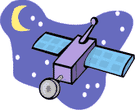The First Satellites
Laura B / Physics #337 / 19 May 1997

In the mid-1950s, the desire to learn more about space led to the development
of satellites. A satellite is a man-made object put into orbit around a
larger body. Scientists, astronomers, and others were eager to learn about
the new space environment, and hopefully make breakthroughs in communications,
weather, and manned space flight.
First
International Satellite Plans
The United States and Russia were the first two nations to draw plans for
an artificial satellite. In 1955, the United States and Russia publicly
announced their proposals concerning the construction of satellites. Within
two years, Russia accomplished their goal, and the United States followed
closely behind.
Sputnik 1
Sputnik 1 was the first artificial satellite to bring the Space Age to
life. On October 4, 1957, the Soviet Union launched Sputnik 1. Its official
Russian name was Iskustvennyi Sputnik Zemli, or "Fellow Traveler of the
Earth." Sputnik 1 was launched by Russia's Old Number Seven rocket at Baikonur
Cosmodrome. The once secret cosmodrome is what makes Russia lead the rest
of the world in launching men and machines into space month after month.
Sputnik 1 was described as "a silver-zinc battery and a radio transmitter
in a 23 inch polished aluminum ball" (Curtis 1). The satellite was also
pressurized with nitrogen circulated by a cooling fan. Two eight-feet and
two ten-feet radio antenna whips were secured to the outside of the satellite
to transmit radio signals. "For three weeks, as it twirled around the world
every 96 minutes in a globe-girdling orbit 588 miles above our heads, Sputnik
beep-beeped its visionary message of a future above the ocean of air" (Curtis
1). After 92 days, Sputnik 1 burned as it fell from orbit into the atmosphere
January 4, 1958.
Explorer 1
Explorer 1 was the first satellite launched by the United states. On January
31, 1958 the United States of America's Jupiter-C rocket launched Explorer
1 at Cape Canaveral. The Army was responsible for the preparation of Explorer
1. The army was asked by Washington officials to try to send a satellite
to orbit because they were worried about losing prestige. Four months after
Russia orbited Sputnik 1 the United States entered the space race as well.
International
Satellite Builders
Many other nations in Asia and Europe soon joined the race in space by
launching satellites. "The majority of satellites have been built by Russia
and the United States, but the countries of Western Europe in the European
Space Agency, Japan, China, India, Canada, Israel, Brazil and others are
actively engaged in satellite development" (Curtis 6). France's Diamont
rocket launched its first satellite Asterix 1 in Algeria on November 26,
1965. On February 11, 1970 Japan's Lambda 4S-5 rocket launched its first
satellite Ohsumi from Kagoshima. China's Long March-1 rocket soon followed
launching its first satellite Mao 1 from Inner Mongolia on April 24, 1970.
A year and a half later on October 28, Britain's Black Arrow rocket launched
its first satellite Black Knight 1 from Woomera Australia. Europe's rocket
Ariane launched its first satellite CAT from Kourou in French Guiana on
December 24, 1979. Rohini 1, the first satellite made by India, was launched
from Sriharikota Island on July 18,1980. Israel_s Shavit rocket fired its
first satellite Horizon 1 from Negev Desert on September 19,1988. Iraq
followed a year later when it launched Rocket 3rd Stage from Al-Anbar on
December 5.
Conclusion
The first satellites led the way to most of our knowledge concerning space
today. Because of the success of many of the first satellites, extensive
research could be done about the Solar System using the pictures and information
retrieved by the satellites. Since 1957, more than 4100 satellites have
successfully been launched. With all the technology created day after day,
our knowledge of space has become very sophisticated and will continue
to grow.
Reference Section
Curtis, Anthony R. Space Satellite Handbook. Houston: Gulf Publication
Company, 1994.
"First United States Satellite." 1996 Information Please Almanac.
Annual 1996: 319. Infotrac.
CD - ROM. Houghton Mifflin Company, 1996.
Oberright, John E. "Satellite." World Book Encyclopedia. 1995 ed.
Shapiro, Margaret. "Site of First Steps into Outer Space Slips into Poverty."
The Washington
Post. 18 March 1995. A1. Infotrac. CD-ROM. 1995.
